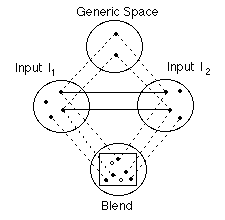Two other elements need to be added to my little linguistics for poets curriculum. The first is the application of a single simple idea, the Parsimony Principle, a concept as old as Occam’s Razor, tho in linguistics normally traced to the work of Charles Fillmore, Paul Kay & Mary Catherine O’Connor. The principle, which in science implies that the simplest explanation is always best, because adding unnecessary extraneous details is a terrific way of introducing errors, has a practical corollary in the reading or listening of any person – the mind will always bring together ideas in ways that “make sense.” If a narrative or figurative explanation is conceivable, then that is how the language-consuming mind will conceive it.
I go on about this at length in The New Sentence, a book that is still in print, but for the sake of this discussion lets look at Chomsky’s “meaningless” sentence, Colorless green ideas sleep furiously. It doesn’t take much to make this a figurative, but comprehensible statement. All one needs to do is interpret “green” not as a color but as implying young, immature, incipient, as in That is a green youth. Let’s assign an example of such a colorless green idea, for example the idea that marriage might be available to all people, rather than constrained only for a few. Marriage is not the most colorful idea. However, we’ve seen that there is quite a bit of opposition to this colorless green idea when it gets applied to gays & lesbians, so it is possible that, for a time at least (e.g., the next four years), this idea might go underground where it might ferment or percolate or, as Chomsky puts it so well, sleep furiously. Thus Colorless green ideas sleep furiously is a perfectly reasonable expression of the pent-up frustration of gay activists to the present political context.
The Parsimony Principle is important, because it is the engine that drives interpretation & thus is at the heart of close reading, the single essential critical tool that every poet needs to possess. There is no way to govern how a reader will take a given statement, but one can learn to control how much, or how little, room for the introduction of extraneous context exists in a given passage. Again, there’s a lengthy demonstration of this in The New Sentence, employing a poem by Rae Armantrout.
The second element is Cognitive Linguistics, which today is the dominant mode of post-Chomskyan work in that field, especially the advances being made around cognitive blends, discourse frames and metaphor. Cognitive blending is the process through which the parsimony principle functions, and it can literally be diagrammed for something like Colorless green ideas as follows:
Input I¹ is the actual phrase as used. But since there is an apparent contradiction between Colorless and green, the language-consuming mind imports Input I², suggesting that green refers not to a color, but to a stage of development. Generic Space is the literal meaning of the individual words in the phrase – it’s where Chomsky goes with his example, but in fact the reading/listening mind, having imported the second input, warranted or not, arrives at the Blend, which makes perfect sense. This process is repeated at a second, higher level in my example when I import the current political climate as an input that now enables me to create a meaning or blend in which Colorless green ideas sleep furiously may be a gaudy figure of speech, but is hardly the epitome of meaninglessness that Chomsky first imagined.
There is an enormous amount now being written about cognitive linguistics, of which my personal favorite happens to be Philosophy in the Flesh by George Lakoff and Mark Johnson. Lakoff’s works in particular are of value, not only because he has done so much work on the problems of metaphor, but also because he reads & understands contemporary poetry. In fact, it was poetry that first brought Lakoff, then a math major undergrad at MIT, to linguistics. When he took an elective in the subject, his teacher just happened to be . . . Roman Jakobson!






